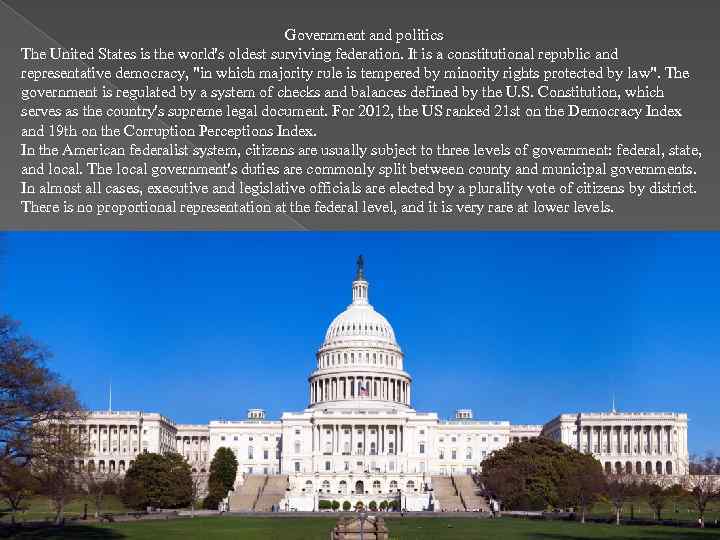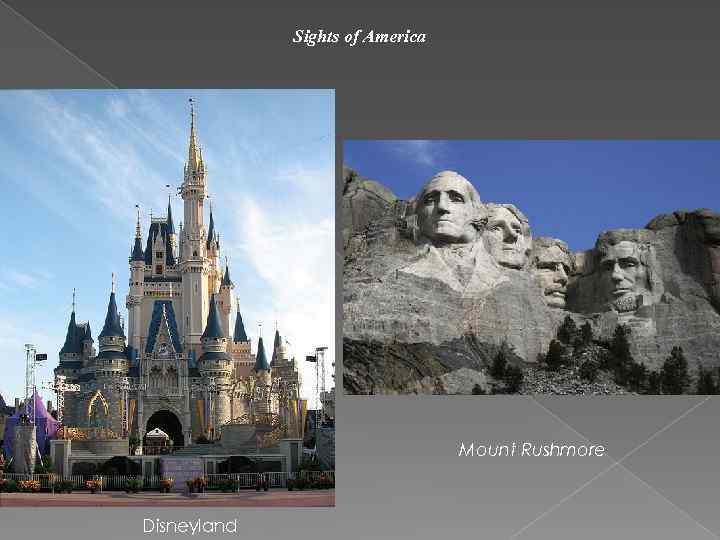 USA
USA
 America, or simply the States, is a federal republic consisting of 50 states, 16 territories, and a federal district. The 48 contiguous states and the federal district of Washington, D. C. , are in central North America between Canada and Mexico. The state of Alaska is the northwestern part of North America and the state of Hawaii is an archipelago in the mid-Pacific. The country also has five populated and nine unpopulated territories in the Pacific and the Caribbean. The largest of these territories are Puerto Rico and the American Virgin Islands which are an official part of the United States. At 3. 79 million square miles (9. 83 million km 2) in total and with around 316 million people, the United States is the fourth-largest country by total area and third largest by population.
America, or simply the States, is a federal republic consisting of 50 states, 16 territories, and a federal district. The 48 contiguous states and the federal district of Washington, D. C. , are in central North America between Canada and Mexico. The state of Alaska is the northwestern part of North America and the state of Hawaii is an archipelago in the mid-Pacific. The country also has five populated and nine unpopulated territories in the Pacific and the Caribbean. The largest of these territories are Puerto Rico and the American Virgin Islands which are an official part of the United States. At 3. 79 million square miles (9. 83 million km 2) in total and with around 316 million people, the United States is the fourth-largest country by total area and third largest by population.
 The United States is a developed country and has the world's largest national economy, with an estimated GDP in 2013 of $16. 7 trillion – 23% of global nominal GDP and 19% at purchasing-power parity. The per capita GDP of the U. S. was the world's sixth-highest in 2010 and the U. S. has the highest mean and second-highest median household income in the OECD as well as the highest average wage. The U. S. has the fourth most unequal income distribution among OECD nations with roughly 16% of the population living in poverty. The economy is fueled by an abundance of natural resources, a well-developed infrastructure, and the world's highest worker productivity; and while its economy is considered post-industrial, the U. S. continues to be one of the world's largest manufacturers. The country accounts for 39% of global military spending, being the foremost economic and military power, a prominent political and cultural force in the world, and a leader in scientific research and technological innovation.
The United States is a developed country and has the world's largest national economy, with an estimated GDP in 2013 of $16. 7 trillion – 23% of global nominal GDP and 19% at purchasing-power parity. The per capita GDP of the U. S. was the world's sixth-highest in 2010 and the U. S. has the highest mean and second-highest median household income in the OECD as well as the highest average wage. The U. S. has the fourth most unequal income distribution among OECD nations with roughly 16% of the population living in poverty. The economy is fueled by an abundance of natural resources, a well-developed infrastructure, and the world's highest worker productivity; and while its economy is considered post-industrial, the U. S. continues to be one of the world's largest manufacturers. The country accounts for 39% of global military spending, being the foremost economic and military power, a prominent political and cultural force in the world, and a leader in scientific research and technological innovation.
 Climate The United States, with its large size and geographic variety, includes most climate types. To the east of the 100 th meridian, the climate ranges from humid continental in the north to humid subtropical in the south. The southern tip of Florida is tropical, as is Hawaii. The Great Plains west of the 100 th meridian are semi-arid. Much of the Western mountains are alpine. The climate is arid in the Great Basin, desert in the Southwest, Mediterranean in coastal California, and oceanic in coastal Oregon and Washington and southern Alaska. Most of Alaska is subarctic or polar. Extreme weather is not uncommon—the states bordering the Gulf of Mexico are prone to hurricanes, and most of the world's tornadoes occur within the country, mainly in the Midwest's Tornado Alley.
Climate The United States, with its large size and geographic variety, includes most climate types. To the east of the 100 th meridian, the climate ranges from humid continental in the north to humid subtropical in the south. The southern tip of Florida is tropical, as is Hawaii. The Great Plains west of the 100 th meridian are semi-arid. Much of the Western mountains are alpine. The climate is arid in the Great Basin, desert in the Southwest, Mediterranean in coastal California, and oceanic in coastal Oregon and Washington and southern Alaska. Most of Alaska is subarctic or polar. Extreme weather is not uncommon—the states bordering the Gulf of Mexico are prone to hurricanes, and most of the world's tornadoes occur within the country, mainly in the Midwest's Tornado Alley.
 Government and politics The United States is the world's oldest surviving federation. It is a constitutional republic and representative democracy, "in which majority rule is tempered by minority rights protected by law". The government is regulated by a system of checks and balances defined by the U. S. Constitution, which serves as the country's supreme legal document. For 2012, the US ranked 21 st on the Democracy Index and 19 th on the Corruption Perceptions Index. In the American federalist system, citizens are usually subject to three levels of government: federal, state, and local. The local government's duties are commonly split between county and municipal governments. In almost all cases, executive and legislative officials are elected by a plurality vote of citizens by district. There is no proportional representation at the federal level, and it is very rare at lower levels.
Government and politics The United States is the world's oldest surviving federation. It is a constitutional republic and representative democracy, "in which majority rule is tempered by minority rights protected by law". The government is regulated by a system of checks and balances defined by the U. S. Constitution, which serves as the country's supreme legal document. For 2012, the US ranked 21 st on the Democracy Index and 19 th on the Corruption Perceptions Index. In the American federalist system, citizens are usually subject to three levels of government: federal, state, and local. The local government's duties are commonly split between county and municipal governments. In almost all cases, executive and legislative officials are elected by a plurality vote of citizens by district. There is no proportional representation at the federal level, and it is very rare at lower levels.
 The federal government is composed of three branches: Legislative: The bicameral Congress, made up of the Senate and the House of Representatives, makes federal law, declares war, approves treaties, has the power of the purse, and has the power of impeachment, by which it can remove sitting members of the government. Executive: The president is the commander-in-chief of the military, can veto legislative bills before they become law (subject to Congressional override), and appoints the members of the Cabinet (subject to Senate approval) and other officers, who administer and enforce federal laws and policies. Judicial: The Supreme Court and lower federal courts, whose judges are appointed by the president with Senate approval, interpret laws and overturn those they find unconstitutional. The House of Representatives has 435 voting members, each representing a congressional district for a two-year term. House seats are apportioned among the states by population every tenth year. At the 2010 census, seven states had the minimum of one representative, while California, the most populous state, had 53. The Senate has 100 members with each state having two senators, elected at-large to sixyear terms; one third of Senate seats are up for election every other year. The president serves a four-year term and may be elected to the office no more than twice. The president is not elected by direct vote, but by an indirect electoral college system in which the determining votes are apportioned to the states and the District of Columbia.
The federal government is composed of three branches: Legislative: The bicameral Congress, made up of the Senate and the House of Representatives, makes federal law, declares war, approves treaties, has the power of the purse, and has the power of impeachment, by which it can remove sitting members of the government. Executive: The president is the commander-in-chief of the military, can veto legislative bills before they become law (subject to Congressional override), and appoints the members of the Cabinet (subject to Senate approval) and other officers, who administer and enforce federal laws and policies. Judicial: The Supreme Court and lower federal courts, whose judges are appointed by the president with Senate approval, interpret laws and overturn those they find unconstitutional. The House of Representatives has 435 voting members, each representing a congressional district for a two-year term. House seats are apportioned among the states by population every tenth year. At the 2010 census, seven states had the minimum of one representative, while California, the most populous state, had 53. The Senate has 100 members with each state having two senators, elected at-large to sixyear terms; one third of Senate seats are up for election every other year. The president serves a four-year term and may be elected to the office no more than twice. The president is not elected by direct vote, but by an indirect electoral college system in which the determining votes are apportioned to the states and the District of Columbia.
 Sights of America Mount Rushmore Disneyland
Sights of America Mount Rushmore Disneyland
 Stone Mountain Zion National Park
Stone Mountain Zion National Park
 Adirondack Mountains Bryce Canyon
Adirondack Mountains Bryce Canyon
 Mesa Verde National Park
Mesa Verde National Park


